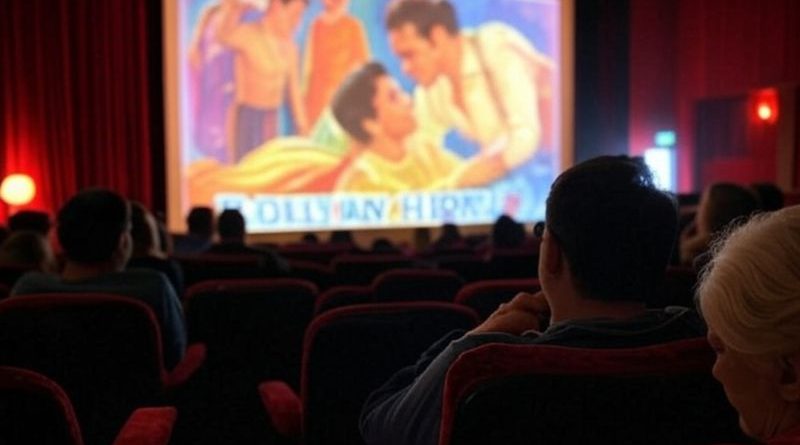Nostalgia on the Big Screen: The Resurgence of Bollywood Re-releases
As cherished classics return to theaters across India, we explore why audiences are flocking to experience films they already know and love.
In early 2025, a curious phenomenon continues to sweep across Indian cinema: theaters are filling up not just for the latest blockbusters, but for films that first graced screens years—sometimes decades—ago. From cult classics like Tumbbad to romantic favorites like Rehnaa Hai Terre Dil Mein, Bollywood’s past is experiencing a vibrant present. But what’s driving this nostalgic renaissance, and what does it tell us about the current state of Indian cinema?
The Power of Nostalgia in Modern Cinema
When Karan Arjun returned to theaters in late 2024, something remarkable happened. Audiences who had watched the film countless times on television or streaming platforms eagerly purchased tickets, creating an atmosphere more akin to a celebration than a simple movie screening. Fans recited dialogues in unison and sang along to beloved songs like attendees at a concert.
This collective nostalgia has proven to be a powerful force. The emotional connection to these films transcends mere entertainment—it represents a return to formative moments, simpler times, and shared cultural touchstones. For many viewers in their 30s and 40s, films from the 90s and early 2000s are wrapped in the warm glow of youth.
“There’s something magical about seeing these films exactly as they were meant to be seen—on the big screen, with surround sound, in a roomful of people who love them just as much as you do,” says film enthusiast Priya Mehta, who attended three different re-releases in the past month alone.
Also Read: Sreeleela Welcomes New Baby Girl Into her Family: Shares Heartwarming Moments
Economic Practicality Behind the Revival
The re-release trend isn’t driven solely by sentimentality—there are practical business considerations at play. With many high-profile new releases underperforming in 2024, including expected hits like Kalki 2898 AD, Maidaan, and Fighter, theaters have faced a content drought.
Re-releases offer a low-risk solution. The initial production costs have already been recouped, making any box office returns largely profit. Marketing expenses are minimal compared to new releases, often relying on social media buzz and existing fan bases rather than expensive promotional campaigns.
For theater owners, particularly those operating multiplexes in urban centers, these re-releases provide reliable programming during slower periods. Even modest attendance numbers can prove financially viable given the low overhead costs.
A Second Life for Overlooked Gems
Perhaps the most fascinating aspect of this trend is how it’s giving certain films a second chance at the recognition many believe they deserved all along.
Tumbbad, which initially released in 2018 to critical acclaim but modest box office returns, has become the standout success story of the re-release wave. Upon its return to theaters in 2024, the horror-fantasy film earned an impressive 30-32 crore rupees—far exceeding its original run and cementing its status as a modern classic. This successful re-release has even sparked the announcement of a sequel, showcasing how these second chances can revitalize careers and franchises.
Similarly, Laila Majnu (2018) benefited tremendously from lead actress Triptii Dimri’s rising stardom, earning nearly triple its initial box office take during its 2024 re-release.
Also Read: Heads of State: Prime Video’s Explosive Action-Comedy Set to Premiere This Summer
The Theatrical Experience in a Streaming Era
Despite the convenience of streaming platforms, where many of these re-released films are readily available, audiences are still willing to pay premium prices for theater tickets. This contradicts the narrative that theatrical viewing is becoming obsolete in the age of digital consumption.
What’s driving this contradiction? The answer lies in the unique communal experience theaters provide. Watching Rockstar or Jab We Met in a room full of fans creates a shared emotional journey impossible to replicate at home. The immersive quality of theatrical viewing—with professional sound systems and large screens—enhances the artistic elements of these films in ways home viewing cannot match.
“I’ve seen Rehnaa Hai Terre Dil Mein at least twenty times on television, but watching it in a theater was a completely different experience,” explains Rahul Sharma, a Mumbai-based marketing professional. “Hearing everyone around me react to the same moments, feeling the collective emotion—it made me fall in love with the film all over again.”
Marketing Mastery: Timing and Strategy
The strategic timing of these re-releases often coincides with significant milestones or capitalizes on current cultural moments. *Maine Pyar Kiya* returned to theaters for its 35th anniversary, while *Laila Majnu*’s re-release was perfectly timed to capitalize on Triptii Dimri’s rising popularity.
Social media plays a crucial role in building momentum. Films that have generated memes, viral content, or renewed online discussion become natural candidates for re-release. This digital buzz creates a ready-made audience eager to translate their online enthusiasm into an in-person experience.
The Sustainability Question: Is This a Lasting Trend?
While the re-release phenomenon shows no signs of immediate decline, industry experts have raised concerns about potential oversaturation. Not every re-release has been successful—*Wake Up Sid* failed to attract significant audiences, while *Veer Zaara* earned a modest 3-4 crore rupees.
Trade analyst Joginder Tuteja has cautioned that overdoing the trend could diminish its appeal: “The novelty factor plays a huge role in these re-releases. If theaters start bringing back films indiscriminately, audiences will become more selective about which nostalgic journeys they’re willing to pay for.”
The collective earnings from re-releases in 2024—approximately 50-60 crore rupees according to industry reports—suggest this is a valuable supplementary strategy rather than a replacement for new content. As new productions regain momentum, the volume of re-releases may naturally decrease.
Finding the Balance: Tradition and Innovation
The re-release trend reveals something important about audience preferences: while innovative storytelling and fresh narratives remain essential, there’s enduring value in the classics that have shaped Indian cinema. Rather than viewing this as a rejection of new content, it represents a balanced appreciation for both tradition and innovation.
For filmmakers, this offers an opportunity to study what makes these re-released films resonate across generations. The enduring appeal of Sholay, Mughal-E-Azam, or more recent classics like Rockstar provides valuable insights into storytelling elements that transcend time.
For audiences, re-releases offer a chance to connect with film history in its proper context—on the big screen—while providing an entry point for younger viewers to experience influential works as they were meant to be seen.
Also Read: Tamannaah Bhatia and Sidharth Malhotra Team Up for Mythological Thriller ‘Vvan’
Looking Forward: The Future of Re-releases
As 2025 progresses, the industry continues to experiment with this model. Potential re-releases like Swades are generating buzz, while successful re-releases like Tumbbad are influencing production decisions for new content.
The most likely scenario is that re-releases will find a sustainable rhythm within the broader cinema ecosystem—perhaps focusing on significant anniversaries, films with genuine cult followings, or works that were ahead of their time upon initial release.
What’s clear is that despite evolving viewing habits and technologies, the theatrical experience remains irreplaceable for many film lovers. The communal nature of cinema—sitting in a darkened room with strangers united by a shared passion—continues to hold unique cultural significance.
As both a celebration of cinematic heritage and a practical business solution, the re-release trend may ebb and flow, but the underlying appreciation for experiencing great films in their intended format seems unlikely to fade.
Catch us for latest Bollywood News, Movies Reviews, New Movie Release , and Follow us on Instagram, Twitter, Facebook




